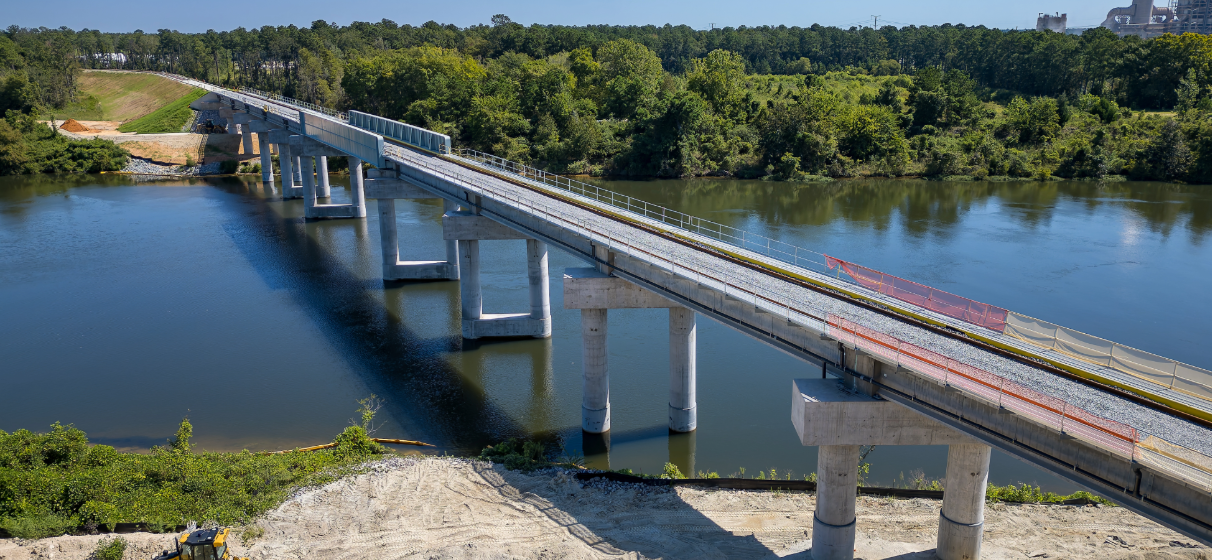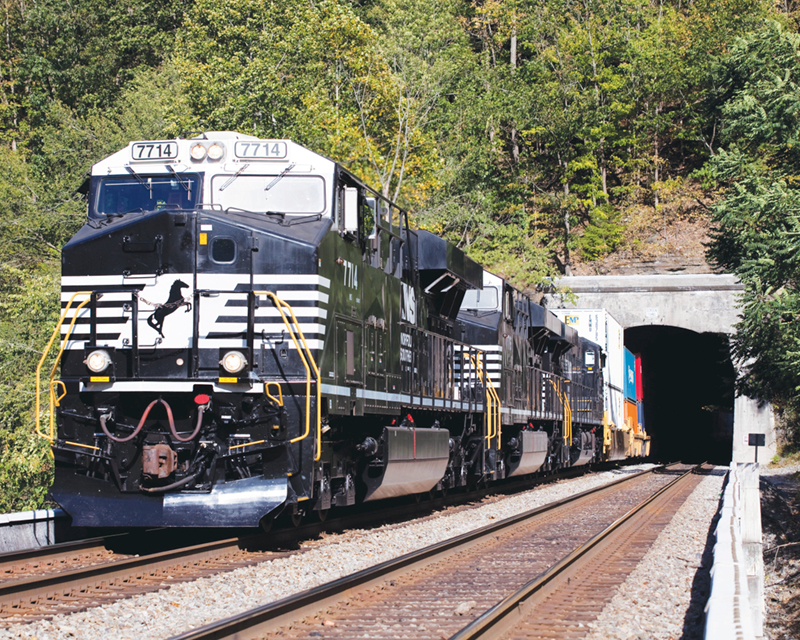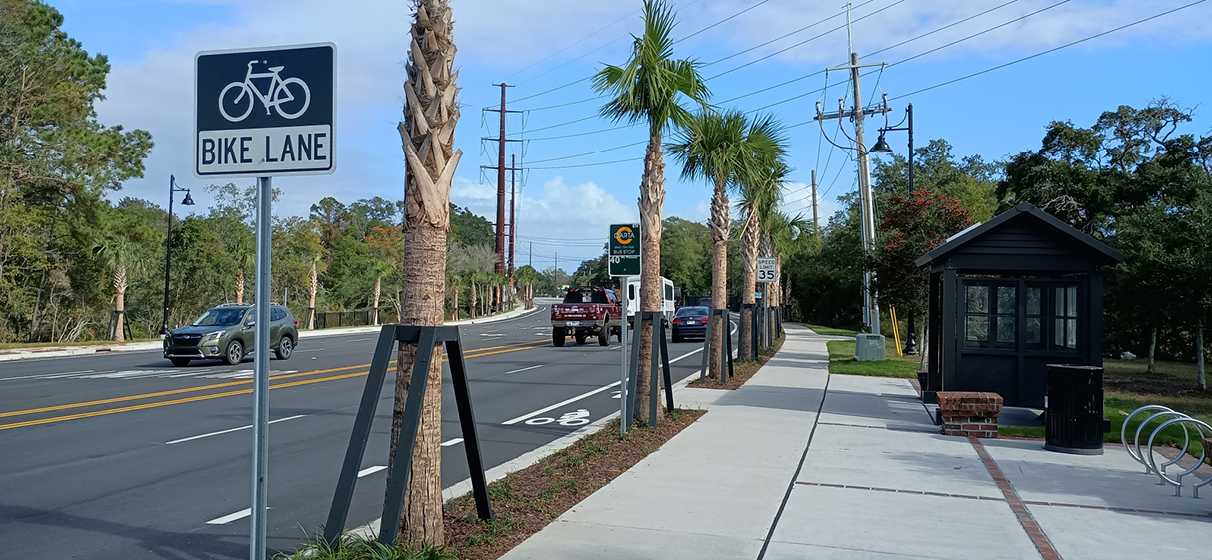In the heart of South Carolina’s Lowcountry, a transformative freight rail corridor is taking shape. The Camp Hall Rail Connection – a $185 million, 23-mile greenfield project led by Palmetto Railways – will connect the Camp Hall Commerce Park to the national freight network via CSX Transportation (CSX). At STV, we’ve had the privilege of helping shape this crucial infrastructure investment, working side-by-side with Palmetto Railways to deliver a complex, multi-phased rail line that balances the demands of economic growth with the environmental sensitivities of the region.
Camp Hall is a 6,800-acre industrial park in Berkeley County, developed to support heavy industry and anchor major investments in automobile production and sustainable battery manufacturing. Just 30 miles outside of Charleston, it’s home to major businesses like Volvo Cars and Redwood Materials and is positioned to become one of the region’s key logistics hubs. However, until now, the park’s only access to the broader freight network was by highway – contributing to congestion and limiting long-term shipping flexibility. The new rail connection changes that, providing a direct link between tenants and the national freight rail network, and relieving pressure on local highways by shifting significant volumes of cargo from trucks to rail.
A Regional Freight Corridor Anchored by Industrial Growth
Palmetto Railways, a Class III short line railroad and a division of the South Carolina Department of Commerce, tapped STV as project manager and lead designer. Our team has led civil and track design, highway and bridge engineering, stormwater and drainage planning, signal layout and permitting coordination throughout design and construction.
In total, the corridor includes 23 miles of mainline track and is supported by more than 10,000 feet of additional yard tracks. Designed for 25 mph operations, the corridor also introduces 32 new at-grade crossings – nine on public roadways and 23 on private access roads – and two new rail bridges spanning major waterways: the Diversion Canal and the Williams Branch floodplain near Westvaco Road.
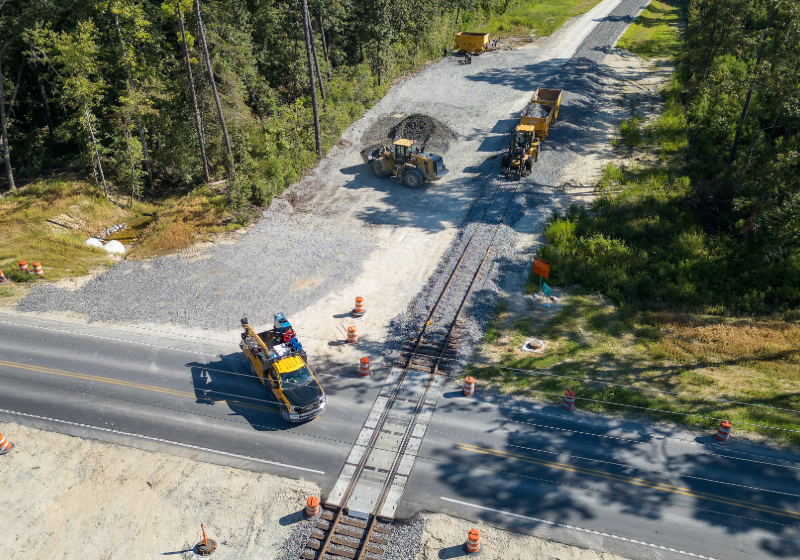
Designing Through Wetlands, Waterways and Poor Soils
What makes the project uniquely challenging isn’t just its size – it’s the terrain. This region of coastal South Carolina is defined by flat, swampy land with high water tables, poor soils and extensive wetlands. The corridor crosses more than 40 distinct watersheds and one navigable waterway. Building resilient, maintainable infrastructure here required a highly coordinated approach to permitting, drainage, structural design and geotechnical engineering.
To meet these challenges head-on, STV, in collaboration with key subconsultants, worked across disciplines and agencies to develop tailored solutions. Six key focus areas helped shape the final design:
- Permitting and NEPA Compliance: Due to the corridor’s environmental sensitivity, permitting was a major undertaking. The project required a Section 404 permit from the U.S. Army Corps of Engineers (USACE), which mandated that the rail embankment preserve natural drainage patterns and not increase water surface elevations or alter flood zones – even during major storm events. STV also supported Palmetto Railways in their coordination with the Surface Transportation Board (STB) and Federal Railroad Administration (FRA), both of which were engaged as co-permitting agencies – a unique arrangement for this region. Meeting these requirements demanded extensive coordination and robust stormwater design, ensuring the final corridor aligned with NEPA commitments while remaining constructible and resilient.
- Hydrology and Drainage Design: The corridor’s flat topography and dense wetland systems meant that conventional drainage strategies wouldn’t work. Instead of relying on deep ditches and large culverts at select locations, our team deployed a distributed drainage system – placing more than 500 pipe culverts and 32 box culverts along the route. These structures were sized and located using a mix of FHWA HY-8, USACE HEC-RAS and 2D modeling, with special attention paid to sensitive areas like the Williams Branch floodplain. Based on hydrologic analysis and design led by our subconsultant Michael Baker International, STV designed the culvert and drainage structures to preserve floodplain connectivity and minimize the rail line’s hydrologic impact.
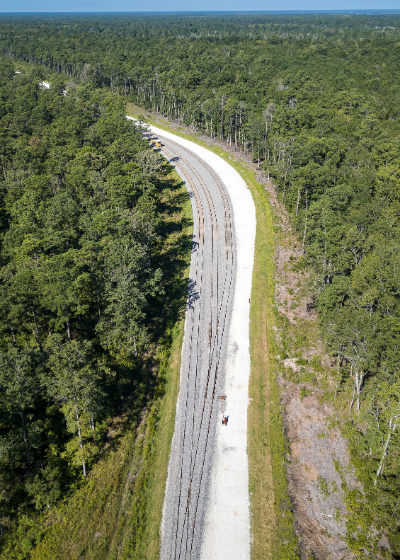
- Geotechnical Engineering: Soil conditions along the route – particularly the high moisture content and organic material – required significant subgrade treatment. STV worked with the project’s geotechnical design delivery partner, Insight Group, to develop two strategies based on fill height, both using geosynthetics and granular bridge lifts to improve stability. In areas like the Diversion Canal bridge approach, where legacy soil stockpiles contained unknown fill materials, we implemented a tailored grading plan and strict geotechnical monitoring. Throughout the corridor, on-site soil was reused where possible, minimizing import needs and keeping the project cost-effective.
- Track Alignment and Embankment Design: STV modeled the entire 23-mile corridor in 3D using Bentley OpenRail Designer, optimizing vertical and horizontal geometry while staying within right-of-way boundaries. We worked to provide proper cover over culverts, minimize elevation changes at crossings and reduce grading volumes wherever possible. The final track design uses continuous welded 136RE rail with steel cross ties and No. 10 turnouts – balancing long-term durability with operational performance.
- Crossing and Signal Design: Of the 32 new at-grade crossings, nine intersect public SCDOT roadways and include full active warning systems. STV designed each crossing in accordance with AREMA, MUTCD and SCDOT standards, incorporating four-quadrant gates, flashing LED signals, electronic bells and redundant power systems to ensure safety and reliability. Diagnostic field studies guided the final signal layout, while private access routes were realigned or terminated, when possible, to reduce potential conflict points.
- Stakeholder and Utility Coordination: A corridor of this length intersects dozens of public and private interests. From roadway reconfigurations to high-voltage power lines, water systems, telecom and fiber, the potential for utility conflict was significant. STV worked closely with SCDOT and utility owners to identify conflicts early and advance relocation plans alongside final rail design. Our team designed the waterline relocations in accordance with Berkeley County Water and Sewer requirements. Our coordination also extended to permitting and landowner access agreements, helping the project avoid costly redesigns or construction delays.
- Construction Services: As the engineer-of-record, STV is also supporting the project through construction by reviewing construction submittals, responding to requests for information (RFIs) and evaluating any proposed design variances.
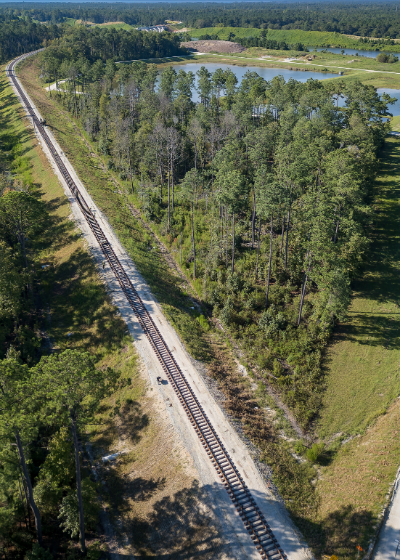
A Phased Approach to Delivery
The Camp Hall Rail Connection is well underway and being delivered in four phases. Phase 1 – initial track work within the Volvo Cars facility – has already been completed. Phases 2 through 4 – including track installation, drainage infrastructure and bridge construction – began in 2024. The full corridor will be under construction through 2026 and is expected to be operational by the summer of 2026.
From the outset, our approach has emphasized flexibility and coordination. By aligning design milestones with permitting requirements, incorporating material and procurement adaptability and staying closely engaged with stakeholders, we’ve kept the project moving forward while managing risk in a challenging environment.
Long-Term Value for South Carolina
Once operational, the Camp Hall Rail Connection will do more than serve existing tenants – it will help position South Carolina’s Lowcountry as a more competitive, connected and sustainable industrial hub. The project enables multimodal freight movement, reduces regional highway congestion and unlocks new opportunities for manufacturing and logistics growth in the greater Charleston region.
It also provides a replicable model for how rail infrastructure can be designed with environmental and regulatory complexity in mind. From drainage to subgrade, every element of this project was tailored to the site and its challenges – without compromising performance or constructability.
We’re proud to be part of the team delivering this corridor and even more proud of how our team adapted best practices and custom solutions to make it possible. The Camp Hall Rail Connection is an investment in the region’s long-term infrastructure capacity – and a testament to the power of early coordination, integrated design and focused execution.
